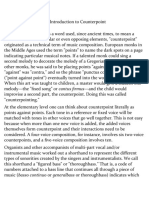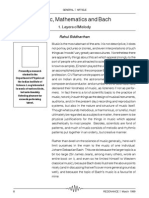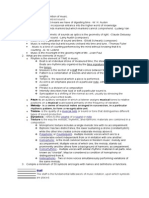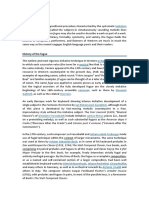The Concept of A Bar
The Concept of A Bar
Uploaded by
kdkdkdCopyright:
Available Formats
The Concept of A Bar
The Concept of A Bar
Uploaded by
kdkdkdOriginal Description:
Original Title
Copyright
Available Formats
Share this document
Did you find this document useful?
Is this content inappropriate?
Copyright:
Available Formats
The Concept of A Bar
The Concept of A Bar
Uploaded by
kdkdkdCopyright:
Available Formats
The concept of a bar
The concept tactus was known in music literature as early as the Renaissance, but the modern concept of a bar was not introduced until the Baroque when the invention of the bar line occurred. The duration of a bar is indicated by the time signature. The concept "bar" is often defined graphically as the space between two bar lines. A bar can be defined in another way as well; in a composition starting with an anacrusis or an incomplete bar (a term used in Finland), the "musical bars" overlap the bars denoted with bar lines.
A composition starting with an anacrusis has no rest at the beginning. The last bar (an incomplete bar, too) will often end before the last beat of the last bar, in order to keep the number of bars in the entire piece at a whole number. An anacrusis at the beginning of a composition is not numbered; notation software numbers it with a nought (0). Upbeat or pickup are other terms used for notes beginning a phrase before the barline. An incomplete bar has a rest at the beginning, making the last bar complete. It is also assigned a number and its duration is usually a half of a complete bar. The rest at the beginning of certain compositions (for example, several of J. S. Bach's two-part inventions) has an intuitive, metrical accent. A rest at the beginning of a composition is impossible to hear; musicians often tend to express it with movement or breathing so that the listener will acquire an idea of the metrics in the composition. The term anacrusis with its equivalents is found in several languages (upbeat, anacrusis, arsis, upptakt), but the term "incomplete bar" is typically Finnish music theory tradition.
You might also like
- Simple Mixology ColorDocument13 pagesSimple Mixology Colorkdkdkd100% (1)
- The Art of Playing Trumpet in The Upper Register - Dissertation.Document147 pagesThe Art of Playing Trumpet in The Upper Register - Dissertation.kdkdkd67% (3)
- Basso ContinuoDocument6 pagesBasso Continuoavefenix75100% (1)
- Langloz ManuscriptDocument9 pagesLangloz ManuscriptJoaquim Moreno17% (6)
- The Art of Accompaniment from a Thorough-Bass: As Practiced in the XVII and XVIII Centuries, Volume IFrom EverandThe Art of Accompaniment from a Thorough-Bass: As Practiced in the XVII and XVIII Centuries, Volume IRating: 5 out of 5 stars5/5 (1)
- Breaking 100 90-80-70 ClampettDocument5 pagesBreaking 100 90-80-70 Clampettkdkdkd100% (1)
- Baroque Music Yr10Document56 pagesBaroque Music Yr10steviebvi100% (1)
- Baroque Glossary of TermsDocument13 pagesBaroque Glossary of TermsChelsea JorolanNo ratings yet
- An Introduction To CounterpointDocument3 pagesAn Introduction To CounterpointOpeyemi ojoNo ratings yet
- Anacrusis - WikipediaDocument12 pagesAnacrusis - Wikipediahakan ÇetinNo ratings yet
- TheBaroquePeriod PDFDocument39 pagesTheBaroquePeriod PDF0millerNo ratings yet
- BWV 1001 1003 1005 GuitarDocument48 pagesBWV 1001 1003 1005 GuitarSergio Bravo100% (1)
- bjm-001 1994 18 265 DDocument21 pagesbjm-001 1994 18 265 DSrđan StanićNo ratings yet
- Music History EssayDocument5 pagesMusic History EssayJoshua HarrisNo ratings yet
- Guide To The Baroque SonataDocument3 pagesGuide To The Baroque SonataOthoniel MejiaNo ratings yet
- Chant-Based Works of John Bull and Adriano BanchieriDocument11 pagesChant-Based Works of John Bull and Adriano BanchieriBridget O'LearyNo ratings yet
- Bach Lecture NotesDocument7 pagesBach Lecture NotesLars RosagerNo ratings yet
- UntitledDocument5 pagesUntitledVoinea PetricaNo ratings yet
- Musical Notation-The History BehindDocument16 pagesMusical Notation-The History BehindAnupam Gurung75% (4)
- Martha Bixler - Renaissance OrnamentationDocument13 pagesMartha Bixler - Renaissance OrnamentationXavier VerhelstNo ratings yet
- New Rich Text DocumentDocument4 pagesNew Rich Text DocumentDorian VoineaNo ratings yet
- Bach - 3.articulationDocument6 pagesBach - 3.articulationPailo76No ratings yet
- Continuo, GroveDocument48 pagesContinuo, GroveJoão Vicente100% (1)
- Bar (Music) - WikipediaDocument4 pagesBar (Music) - WikipediaDiana GhiusNo ratings yet
- Leathwood - Reading BachDocument26 pagesLeathwood - Reading BachDudu BarrettoNo ratings yet
- Bar (Music) : Types of Bar LinesDocument14 pagesBar (Music) : Types of Bar LinesJoshua BoncodinNo ratings yet
- Figured Bass: Basso ContinuoDocument8 pagesFigured Bass: Basso ContinuoMwenya Mulenga100% (1)
- The Baroque German Violin BowDocument61 pagesThe Baroque German Violin BowRoyke JR100% (1)
- Music Forms of The Baroque PeriodDocument6 pagesMusic Forms of The Baroque PeriodLinkoriginal100% (2)
- Bach Music MathsDocument10 pagesBach Music MathsKuntal ChaudhuryNo ratings yet
- Articulation MarksDocument7 pagesArticulation MarksSeungyonNo ratings yet
- Reading Bach's Ideas - Jonathan LeathwoodDocument26 pagesReading Bach's Ideas - Jonathan LeathwoodCainã Rocha100% (6)
- Resumen de Formas MusicalesDocument12 pagesResumen de Formas MusicalesCharlex LópezNo ratings yet
- List of Musical SymbolsDocument15 pagesList of Musical SymbolsNgạn Lê Hữu100% (1)
- Baroque MusicDocument18 pagesBaroque MusicAashish KoliNo ratings yet
- Renaissance PeriodDocument8 pagesRenaissance PeriodOladayoNo ratings yet
- Essential Bach Choir - CH 1: IntroductionDocument6 pagesEssential Bach Choir - CH 1: IntroductionAaron100% (1)
- Hugo Leichtentritt Musical Form The Contrapuntal FormsDocument18 pagesHugo Leichtentritt Musical Form The Contrapuntal FormsmaandozaNo ratings yet
- Baroque Period Part 1Document14 pagesBaroque Period Part 1Krista BaerNo ratings yet
- 2a - NotationDocument4 pages2a - NotationAnonymous epCtyfsRNo ratings yet
- Music of The Baroque PeriodDocument23 pagesMusic of The Baroque Periodcreate foxesNo ratings yet
- List of Musical Symbols - WikipediaDocument129 pagesList of Musical Symbols - WikipediaAshu B Manyo100% (1)
- Da Capo AriaDocument4 pagesDa Capo AriachenamberNo ratings yet
- Module 1 - 2.1 Maam Gemota540Document51 pagesModule 1 - 2.1 Maam Gemota540Febby MillennNo ratings yet
- Music, Mathematics and BachDocument8 pagesMusic, Mathematics and Bachgerimox100% (1)
- Choral Music in Medieval Times: Gustav Mahler'sDocument10 pagesChoral Music in Medieval Times: Gustav Mahler'sarold bodoNo ratings yet
- Booklet UkDocument16 pagesBooklet UksalnasuNo ratings yet
- HocketDocument7 pagesHocketRoberto BonatiNo ratings yet
- Music Notation As Analysis: Nicolas MeeùsDocument7 pagesMusic Notation As Analysis: Nicolas MeeùsNicolas MeeùsNo ratings yet
- BWV-1001-1003-1005-Guitar FFDocument48 pagesBWV-1001-1003-1005-Guitar FFSergio TerebeikoNo ratings yet
- Mapeh ProjectDocument4 pagesMapeh ProjectLeeNo ratings yet
- Baroque Music - WikipediaDocument20 pagesBaroque Music - Wikipediasamsonhui.ch20231106No ratings yet
- A Measured Approach To J.S.bachDocument10 pagesA Measured Approach To J.S.bachevaNo ratings yet
- Nota HarmoniDocument11 pagesNota HarmoniElyn LuNo ratings yet
- FugueDocument4 pagesFugueMoses LiNo ratings yet
- Music 9 Q1 M2Document55 pagesMusic 9 Q1 M2Vanna Rebekah IbatuanNo ratings yet
- A Guide to the Registration of Church Organs - A Selection of Classic Articles on the Technical Aspects of Organ PerformanceFrom EverandA Guide to the Registration of Church Organs - A Selection of Classic Articles on the Technical Aspects of Organ PerformanceNo ratings yet
- On the Execution of Music, and Principally of Ancient MusicFrom EverandOn the Execution of Music, and Principally of Ancient MusicRating: 5 out of 5 stars5/5 (1)
- How Music Developed: A Critical and Explanatory Account of the Growth of Modern MusicFrom EverandHow Music Developed: A Critical and Explanatory Account of the Growth of Modern MusicNo ratings yet
- The secrets of the hidden canons in J.S. Bach's masterpiecesFrom EverandThe secrets of the hidden canons in J.S. Bach's masterpiecesNo ratings yet
- Vision PromptsDocument2 pagesVision PromptskdkdkdNo ratings yet
- E9 Modal Scales - E9modalmemDocument31 pagesE9 Modal Scales - E9modalmemkdkdkd100% (1)
- S. R. Bhatt, Anu Mehrotra, The Dalai Lama Buddhist EpistemologyDocument146 pagesS. R. Bhatt, Anu Mehrotra, The Dalai Lama Buddhist EpistemologyNiraj Kumar100% (1)
- Z - Single Player Game Guide PDFDocument26 pagesZ - Single Player Game Guide PDFkdkdkdNo ratings yet
- The New Era of Singing TrainingDocument37 pagesThe New Era of Singing TrainingChris Hubley77% (13)
- Buzzing The Trumpet MouthpieceDocument5 pagesBuzzing The Trumpet MouthpiecekdkdkdNo ratings yet
- Decapitator ManualDocument11 pagesDecapitator ManualkdkdkdNo ratings yet
- Yb Reader RecipesDocument18 pagesYb Reader RecipesjazzyzNo ratings yet
- S.744 Immigration Reform BillDocument844 pagesS.744 Immigration Reform BillHLMeditNo ratings yet
- Instrument Reference Chart v4Document2 pagesInstrument Reference Chart v4Rosie Chase100% (6)
- Tonal Degrees and Degree TendenciesDocument3 pagesTonal Degrees and Degree Tendencieskdkdkd100% (1)
- 4938 Amador DR Oceanside CADocument4 pages4938 Amador DR Oceanside CAkdkdkdNo ratings yet
- Align PrintDocument8 pagesAlign PrintkdkdkdNo ratings yet











































































